Photobiomodulation (PBM) regenerates gums quickly because it boosts cellular metabolism and promotes tissue healing. This is achieved through targeted light therapy that activates mitochondria, increasing energy production and collagen synthesis. PBM also reduces inflammation, enhancing the healing environment around your gums by lowering harmful cytokines. Additionally, it encourages the proliferation of essential cells, like fibroblasts, that repair tissue, while stimulating crucial growth factors. With increased blood flow and cell viability, your gums recover faster and more effectively. There's much more to discover about PBM's benefits and applications in gum health—keep exploring to learn all the details!
Mechanism of Photobiomodulation
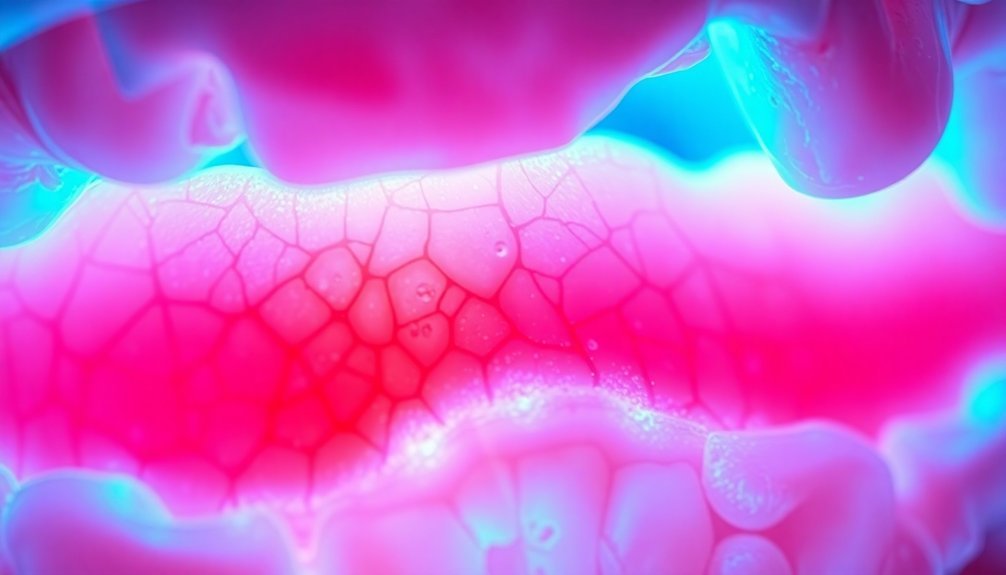
The mechanism of photobiomodulation (PBM) involves a series of interactions that begin when light is absorbed by cellular components, particularly the mitochondria. When this light hits the mitochondria, it targets the Cytochrome C complex in their inner membrane, triggering fundamental photophysical and photochemical events. These events help your cells engage in various biological processes essential for healing.
One of the primary effects you'll notice is enhanced cellular metabolism and stimulated cellular function. As a result, you may experience increased cell proliferation and improved collagen synthesis, which are critical for tissue repair and regeneration. Additionally, PBM has been shown to enhance odontoblast activation enhancing dentin regeneration through the differentiation of dental pulp stem cells into odontoblast-like cells, promoting the formation of new dental tissues.
PBM also aids in differentiating dental pulp stem cells into odontoblast-like cells, promoting the formation of new dental tissues.
Additionally, PBM modulates inflammatory processes, helping reduce swelling and pain after surgical procedures or injuries. It works by decreasing oxidative stress and enhancing antioxidant defense mechanisms, which allows for a faster recovery and alleviates discomfort.
This nonthermal process sets PBM apart from other laser therapies, making it an effective option for gum regeneration and oral health improvement.
Cellular Energy Production
When you expose your cells to red and near-infrared light, mitochondria kick into high gear, absorbing this energy to fuel their activity. This process not only activates cytochrome c oxidase but also boosts ATP synthesis, giving your cells the energy they need for essential functions. With enhanced ATP production, you can support effective gum regeneration and overall tissue healing. Additionally, periodontal therapy has been shown to improve metabolic outcomes in patients with diabetes, highlighting the interconnectedness of oral health and systemic well-being.
Mitochondrial Activation Mechanism
Harnessing the power of light, photobiomodulation specifically targets mitochondrial activation, vital for cellular energy production. When you expose cells to red and near-infrared light, photonic energy is absorbed by cytochrome C oxidase, an essential enzyme located in the inner mitochondrial membrane. This process stimulates the electron transport chain, increasing the availability of electrons and enhancing the mitochondrial membrane potential (Δψm).
With heightened membrane potential, your cells can utilize oxygen more effectively, promoting enzymatic activity and reversing mitochondrial inhibition through nitric oxide release. This collective increase improves overall oxygen consumption and enhances the dynamics of mitochondrial structure. Furthermore, the stimulation of mitochondrial activity through photobiomodulation helps to enhance cellular proliferation and aids in tissue repair processes.
Moreover, altered intracellular redox potential influences cellular metabolism, modifies ion flux, and impacts pH and cAMP levels, all of which play significant roles in cellular signaling. These changes activate various signaling pathways, leading to gene expression modifications that enhance cell migration, proliferation, and tissue repair.
As a result, photobiomodulation not only energizes your cells but also promotes vital regenerative processes, making it an invaluable tool in gum regeneration and healing.
Enhanced ATP Synthesis
Photobiomodulation's activation of mitochondrial processes directly spurs enhanced ATP synthesis, which is vital for cellular energy production. When light from this therapy is absorbed by your mitochondria, it stimulates the electron transport chain, greatly boosting ATP production. This increase enhances your cellular metabolism and restores normal cellular functions, especially in damaged tissues.
With more ATP, your cellular metabolic activities ramp up, promoting cell proliferation and speeding up tissue repair. Elevated ATP levels also support collagen synthesis and improve your body's natural healing processes, while helping to reduce oxidative stress and inflammation.
Moreover, as ATP production rises, it creates mild reactive oxygen species (ROS) that trigger gene transcription essential for cellular repair. This process activates various transcription factors, leading to the production of anti-inflammatory signaling molecules and antioxidant enzymes. As a result, your body can more effectively heal itself.
This enhanced cellular energy not only accelerates wound healing and tissue repair but also supports angiogenesis, boosting blood supply to damaged areas.
Ultimately, the increase in cellular energy contributes to better tissue health, less post-surgical discomfort, and improved overall recovery.
Tissue Regeneration Processes
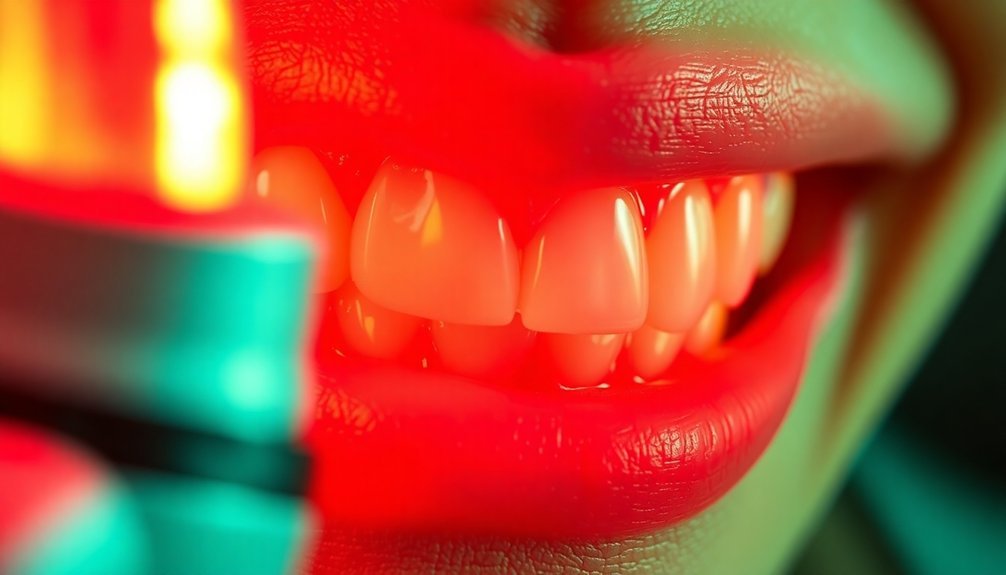
Tissue regeneration processes are essential for healing, and they unfold through several key stages: inflammation, migration, proliferation, differentiation, and maturation.
Inflammation kicks off the healing process, increasing blood flow to the injury site and clearing away damaged tissues with the help of immune cells like macrophages and neutrophils. This stage prepares the wound for what comes next.
Then, migration occurs, bringing in a flood of new cells—immune cells, fibroblasts, and stem cells—that form a scaffold for tissue growth. Growth factors guide these cells to the site, creating a provisional matrix essential for the next step.
During proliferation, cells divide and replicate, healing the tissue and restoring its size and shape. You'll notice increased collagen synthesis and higher ATP production, which energizes the healing process.
Finally, differentiation and maturation take place. Newly created cells specialize into their intended roles while the tissue undergoes remodeling.
Blood vessels form, and collagen or elastin production ramps up, reinforcing the newly healed area. This final stage modulates inflammation, ensuring that the tissue regains its original function and strength, setting the stage for robust regeneration.
Role of Odontoblasts
Odontoblasts play an essential role in dental health by forming and maintaining dentin, the hard tissue that protects the dental pulp. When you undergo photobiomodulation (PBM), it boosts the activity of odontoblasts located at the pulp-dentin interface. This stimulation leads dental pulp stem cells (DPSCs) to differentiate into odontoblast-like cells, critical for generating new dentin. Specific light parameters, particularly near-infrared light, enhance this activation considerably.
Increased odontoblast activity through PBM not only promotes dentin formation but also helps alleviate dental hypersensitivity. If odontoblasts are damaged, PBM triggers the proliferation and differentiation of DPSCs, leading to a regenerative process that restores tooth health.
The interaction of PBM with dental pulp improves mitochondrial function and ATP production, further supporting odontoblast function. Moreover, PBM reduces inflammation, creating a more favorable environment for odontoblast differentiation and dentin regeneration.
Impact on Periodontal Ligament
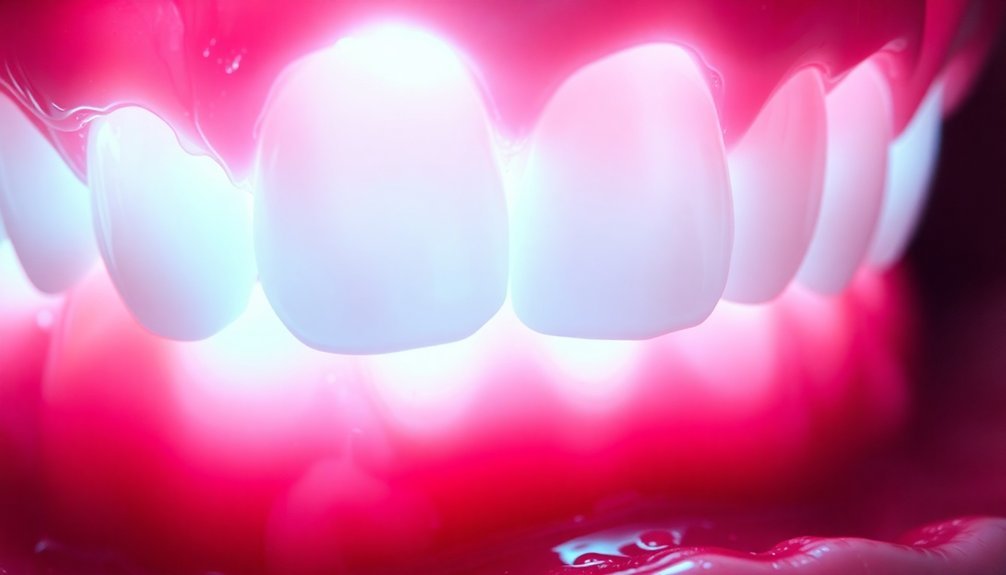
When you look at the impact of photobiomodulation on the periodontal ligament, you'll find enhanced collagen production, which is essential for tissue strength and elasticity.
You'll also notice a mitigated inflammatory response, allowing for a healthier environment for healing.
This combination accelerates tissue regeneration, making it important for effective gum recovery.
Enhanced Collagen Production
Photobiomodulation serves as an essential tool for enhancing collagen production, particularly in the periodontal ligament. By using effective wavelengths between 600-1000 nm, especially the 808 nm laser, you can stimulate significant collagen synthesis.
To achieve this, energy densities of 3-5 J/cm² are typically employed to boost collagen production and promote cell proliferation in periodontal ligament cells. It's critical to avoid exceeding 8 J/cm² for LED devices or 4 J/cm² for lasers, as higher densities can lead to undesirable reactions.
In addition to boosting collagen, photobiomodulation increases the proliferation and migration of these cells, even in stressed conditions like inflammation.
You'll find that repeated irradiation supports sustained enhancements in collagen production due to increased cell viability and metabolic activity. Furthermore, this treatment encourages osteogenic differentiation of ligament cells, which further contributes to collagen synthesis.
Gene expression also plays a role; photobiomodulation upregulates genes associated with collagen production, such as Type I collagen mRNA.
Mitigated Inflammatory Response
Inflammation can greatly impair healing in the periodontal ligament, but you can counteract this effect with photobiomodulation (PBM). By utilizing specific wavelengths of light, particularly in the range of 630-830 nm, you can considerably reduce the expression of inflammatory cytokines like TNF-α, IL-1β, and IL-6 in your cells.
When you apply 808 nm laser irradiation at 3 J/cm², you'll notice marked decreases in these harmful mediators.
Moreover, PBM promotes an anti-inflammatory environment by upregulating the beneficial cytokine IL-10, further mitigating inflammation. This effect isn't limited to normal conditions; it also works under stressed environments, making PBM a versatile treatment option.
The mechanism behind PBM involves the modulation of cytokine expression and a reduction in intracellular reactive oxygen species (ROS), which are known to contribute to inflammation.
Daily PBM treatments leverage this interaction, allowing for higher efficacy. By adhering to ideal energy densities—like sticking below 4 J/cm² for lasers—you'll enhance the healing capabilities of your periodontal ligament, creating a healthier oral environment overall.
Accelerated Tissue Regeneration
Accelerated tissue regeneration plays an essential role in the healing process of the periodontal ligament, especially when you implement targeted therapies like photobiomodulation (PBM). By using an 808 nm laser, you can considerably enhance cell proliferation, particularly at energy densities of 3 J/cm² and 5 J/cm².
Studies show that both normal and inflamed conditions see improved cell viability over time, promoting a rapid regeneration process.
Moreover, PBM not only boosts cell proliferation but also improves cell migration. It encourages periodontal ligament cells to move toward the wound site, which is vital for effective healing. Scratch tests demonstrate a notable increase in migration width following laser treatment, helping speed up tissue repair.
PBM also promotes osteogenic differentiation, further supporting periodontal ligament health. By enhancing markers like ALP, you can stimulate bone formation, essential for periodontal integrity.
When you pair PBM with regenerative techniques, such as stem cell therapy, you can optimize healing outcomes. The combination of these approaches guarantees a robust recovery process for periodontal tissues, facilitating faster regeneration and better long-term success in gum health.
Anti-Inflammatory Mechanisms
A growing body of research highlights the anti-inflammatory mechanisms underlying photobiomodulation in gum regeneration. This innovative therapy decreases pro-inflammatory cytokines like IL-6 and IL-12p70 while boosting levels of IL-10, leading to improved inflammation profiles. By reducing markers of the M1 macrophage phenotype and lowering reactive nitrogen species, photobiomodulation minimizes inflammation-related breakdown of essential oral structures.
Additionally, it effectively modulates oxidative stress. You'll find that it reduces harmful superoxide anions and hydrogen peroxide in gingival cells, while enhancing the scavenging of reactive oxygen species. As a result, it up-regulates antioxidant defenses, further diminishing systemic inflammation.
Moreover, photobiomodulation enhances cell viability and proliferation in microbially challenged gingival cells, promoting cell survival through the activation of key transcription factors. This not only boosts ATP production to bolster cellular functions but also improves the overall barrier function of the gingival epithelium.
In oral tissues affected by periodontal disease or gingivitis, it considerably reduces inflammation, speeds up healing following dental surgeries, and alleviates post-operative discomfort. Overall, these anti-inflammatory actions play an essential role in supporting faster gum regeneration.
Enhancing Healing Factors
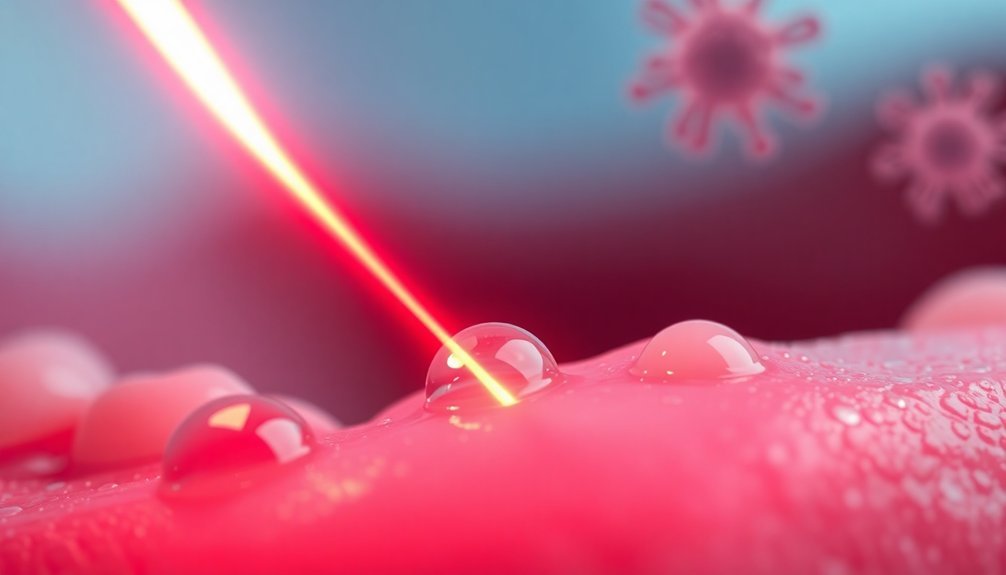
Building on the anti-inflammatory mechanisms of photobiomodulation, enhancing healing factors plays a significant role in gum regeneration. When you undergo photobiomodulation therapy, it notably increases adenosine triphosphate (ATP) production by stimulating your mitochondria. This boost in cellular energy supports essential healing processes like tissue repair and regeneration, ensuring your gum tissues recover effectively after surgery or injury.
Moreover, this therapy promotes cell proliferation, which is fundamental for restoring your gum tissue after dental procedures. By encouraging new cell growth, it fills in damaged areas, accelerating the regeneration process, especially in cases of periodontal disease.
You'll also benefit from improved blood circulation thanks to red light therapy. Enhanced blood flow delivers crucial oxygen and nutrients to the healing site while removing waste products, aiding in faster recovery. It not only supports the delivery of growth factors but also reduces swelling.
Lastly, photobiomodulation therapy assists in repairing tissues throughout your mouth, including gums, teeth, and bone. Its non-invasive nature makes it a safe and effective option, enhancing your overall healing process.
Growth Factor Production
When you apply photobiomodulation (PBM), you're boosting growth factor production, particularly the activation of TGF-beta 1.
This process enhances cellular signaling and increases the release of essential growth factors vital for gum regeneration.
As a result, you'll see improved tissue healing and regeneration in affected areas.
TGF-beta 1 Activation
Activation of TGF-beta 1 plays a fundamental role in enhancing the healing process and promoting tissue regeneration through photobiomodulation (PBM) therapy. When PBM is applied, it triggers TGF-beta 1 production, stimulating key cell types like fibroblasts and macrophages that aid healing. This activation not only mitigates inflammation but also fosters efficient tissue repair.
In studies, PBM-treated injuries showed faster healing and less inflammation, highlighting TGF-beta 1's effectiveness. This growth factor is imperative for the differentiation of fibroblasts into myofibroblasts, which are essential for wound healing.
Here's a quick overview of TGF-beta 1 activation and its role:
| Factor | Impact |
|---|---|
| TGF-beta 1 Induction | Enhances tissue healing |
| Fibroblast Differentiation | Promotes myofibroblast formation |
| Inflammation Reduction | Mitigates inflammatory responses |
| ECM Production | Aids in remodeling and restoration |
| Wound Healing Acceleration | Speeds up recovery in injuries |
When TGF-beta 1 is activated through PBM, it fundamentally sets the stage for robust healing and regeneration, making it a crucial component in gum rehabilitation.
Enhanced Cellular Signaling
Enhanced cellular signaling through photobiomodulation (PBM) markedly boosts growth factor production, which is essential for tissue regeneration. When you undergo PBM treatment, various cellular signaling pathways like MAPKs and JAK/STAT get activated, promoting critical processes for healing.
These activations lead to an increase in ATP production, which reduces oxidative stress and fosters cellular proliferation. Pathways such as ERK and JNK play significant roles in regulating glucose metabolism and enhancing cell survival, both fundamental for repairing tissue damage.
You'll also find that the JAK2/STAT3 pathway aids in cellular proliferation, potentially benefiting cells in your gum tissue as it does for neurons. Moreover, the signaling induced by PBM triggers the release of growth factors that bind to cell surface receptors, starting the gene transcription necessary for cellular growth and repair.
This heightened signaling environment not only encourages the proliferation of dental pulp stem cells but also boosts the activity of odontoblasts and the integrity of connective tissues. Consequently, through enhanced cellular signaling, PBM creates a robust foundation for rapid gum regeneration and healing.
Increased Growth Factor Release
Photobiomodulation (PBM) considerably boosts the release of growth factors, which play a crucial role in tissue regeneration and healing. By stimulating fibroblasts—cells that produce collagen—PBM enhances tissue repair and accelerates the regeneration of gum tissue. With PBM, you're not just improving cell activity; you're actively promoting the release of essential growth factors needed for effective healing.
Here's an overview of the impact of PBM on growth factor release:
| Aspect | Description |
|---|---|
| Fibroblast Stimulation | PBM activates fibroblasts for increased collagen production. |
| Key Growth Factors | PBM induces critical growth factors that aid in cell proliferation and migration. |
| Cell Proliferation | Enhanced growth factor release boosts cell proliferation crucial for healing. |
| Tissue Regeneration | PBM creates a favorable environment for tissue repair by reducing inflammation. |
Clinical Applications in Dentistry
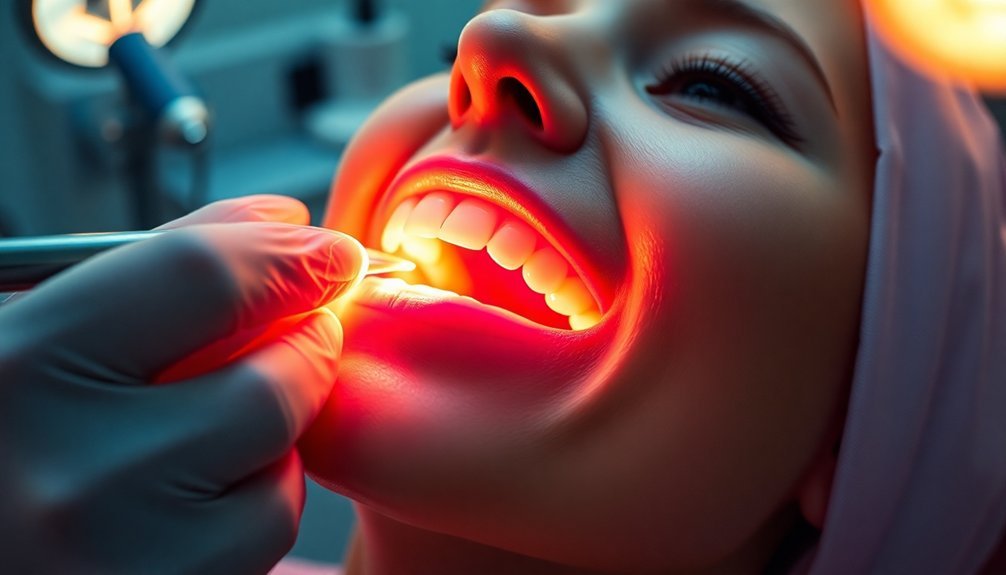
In modern dentistry, clinical applications of photobiomodulation offer significant benefits for gum therapy. You'll appreciate how this advanced technology reduces inflammation and pain during and after dental procedures. By managing inflammation and producing an analgesic effect, it smooths your recovery, minimizing discomfort and reducing bleeding, thereby lowering the risk of complications like dry sockets after tooth extractions.
Moreover, photobiomodulation stimulates tissue regeneration, promoting cell proliferation and increasing collagen production. This means your gum tissue heals faster after extractions and surgeries, enhancing the integration of dental implants and strengthening the periodontal ligament.
The precision of photobiomodulation also plays a role in treating gum disease. It effectively targets and eliminates harmful bacteria in periodontal pockets while leaving healthy tissue intact. This approach not only reduces pocket depth but promotes gum tissue regeneration, making your gums healthier and more aesthetically pleasing.
Finally, integrating this technology with traditional treatments amplifies the healing process, whether after scaling, root planing, or dental implants. It's a versatile tool available in professional settings and for home use, ensuring quality care for your oral health.
Safety of PBM Treatments
When considering gum regeneration therapies, understanding the safety of photobiomodulation (PBM) treatments is crucial. Research shows that PBM doesn't stimulate the growth of malignant cells, making it oncologically safe for managing various tissues. Studies supported by clinical and preclinical data demonstrate no adverse effects on human neoplastic cells. It's reassuring to know that PBM won't increase tumor recurrence or the risk of new tumors.
Also, PBM treatments have no significant clinical side effects when applied correctly. This non-thermal and non-destructive therapy restores ATP levels in mitochondria, promoting healing without harm. Patients across all ages tolerate PBM well.
Key to safety is proper dosage—too low or too high can cause ineffective or inhibitory results. Correct dosing stimulates beneficial cellular processes while avoiding adverse reactions. Certified professionals ascertain these treatments remain safe.
Additionally, PBM shows antimicrobial properties, reducing postoperative infection risk while promoting healing. Its non-invasive nature means there's no collateral damage to surrounding tissues.
Efficiency of Photobiomodulation
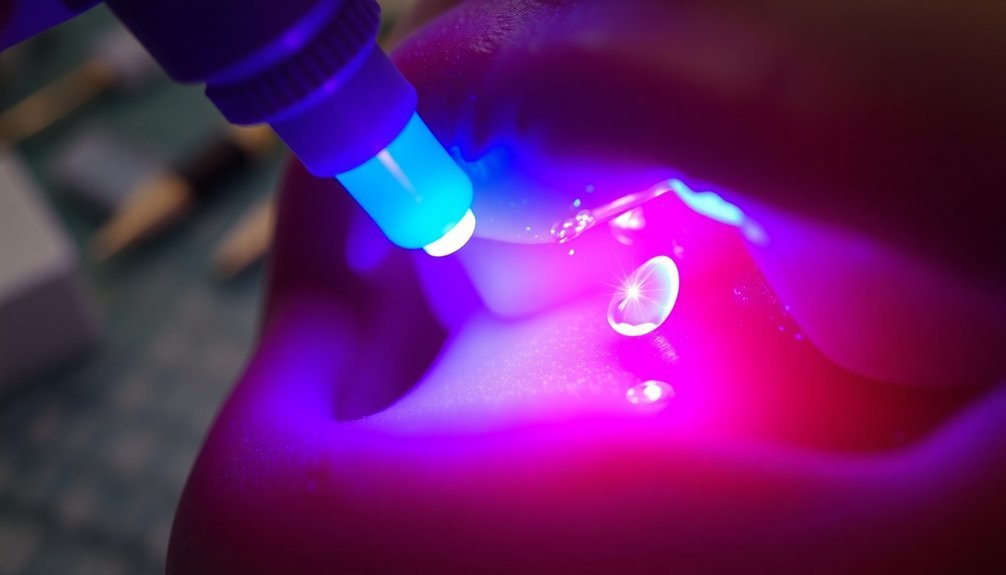
Among the various therapies for gum regeneration, photobiomodulation (PBM) stands out for its impressive efficiency in tissue repair. By utilizing specific wavelengths of light, PBM influences cellular processes, creating an environment that notably accelerates healing. The mechanism behind this efficiency involves enhancing mitochondrial activity, which boosts ATP production and cellular metabolism.
Here are some key benefits of PBM:
- Accelerated Healing: Promotes faster recovery after dental procedures, reducing downtime.
- Pain Relief: Alleviates discomfort through anti-inflammatory effects and improved circulation.
- Tissue Regeneration: Enhances the strength and integrity of tissues, including gums and bone.
- Broad Clinical Applications: Effective in various dental treatments like extractions and periodontal care.
With its multifaceted approach, PBM not only speeds up healing but also minimizes complications, creating better outcomes for patients.
You'll find that the benefits extend beyond immediate gum recovery, promoting long-term oral health and well-being. As a result, more dental professionals are incorporating PBM into treatment plans, optimizing patient care and satisfaction.
Frequently Asked Questions
How Long Does It Take to See Results From PBM Treatment?
You'll typically see results from photobiomodulation treatment in a few days to weeks. Improvements can vary based on treatment frequency, energy density, and the specific condition, so consistency is key for ideal outcomes.
Are There Any Side Effects of PBM Therapy?
PBM therapy's generally safe, with few side effects. Although some patients may experience a mild burning sensation, most report no adverse effects during gum treatment. It's important to monitor individual responses throughout the procedure for maximum safety.
Can PBM Be Combined With Other Dental Treatments?
Absolutely, you can combine PBM with various dental treatments. It enhances healing, reduces pain, and improves the outcomes of procedures like tooth extractions, implants, and cosmetic treatments, ensuring you recover faster and more comfortably.
Who Should Avoid Using PBM Therapy?
You should avoid PBM therapy if you have cancer, are pregnant, suffer from specific medical conditions like a hyperactive thyroid or lymphoma, or are using photosensitizing medications. Always consult a healthcare professional before proceeding.
How Often Should PBM Treatments Be Administered for Optimal Results?
You should aim for PBM treatments every other day for eight weeks, but a few sessions each week can suffice. After initial healing, you can reduce frequency to maintain your results effectively.
In Summary
To summarize, photobiomodulation is a powerful tool for regenerating gums quickly and effectively. By enhancing cellular energy production and promoting tissue regeneration, it supports essential processes like growth factor production and the revitalization of odontoblasts and the periodontal ligament. As a safe and efficient treatment option, PBM can transform your dental care experience, making recovery faster and more effective. Embracing this technology could lead to better oral health and improved outcomes for you and your patients.

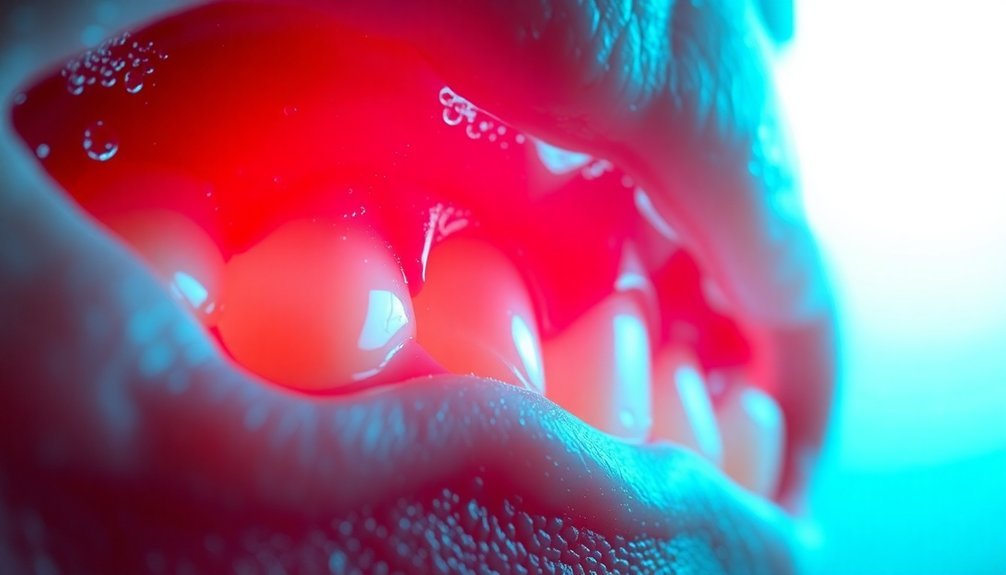



Leave a Reply